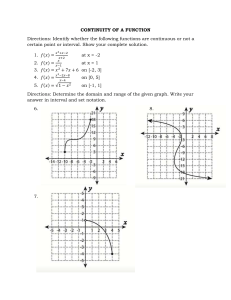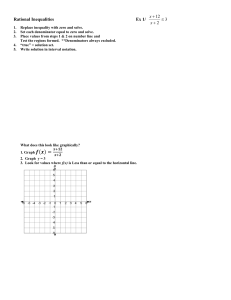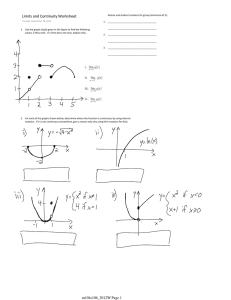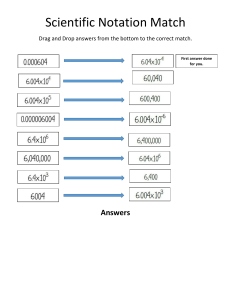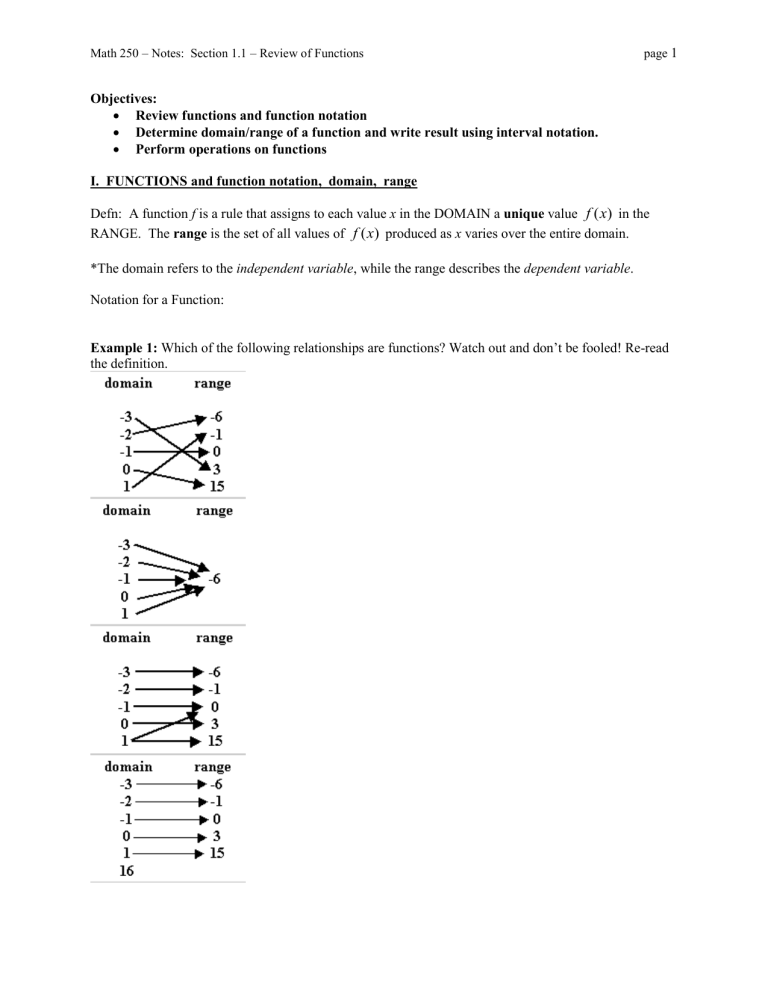
Math 250 – Notes: Section 1.1 – Review of Functions page 1 Objectives: Review functions and function notation Determine domain/range of a function and write result using interval notation. Perform operations on functions I. FUNCTIONS and function notation, domain, range Defn: A function f is a rule that assigns to each value x in the DOMAIN a unique value f ( x) in the RANGE. The range is the set of all values of f ( x) produced as x varies over the entire domain. *The domain refers to the independent variable, while the range describes the dependent variable. Notation for a Function: Example 1: Which of the following relationships are functions? Watch out and don’t be fooled! Re-read the definition. Math 250 – Notes: Section 1.1 – Review of Functions page 2 *One way to determine whether a GRAPH represents a function is to perform the vertical line test Example 2: Using the Vertical Line Test, determine whether each graph represents y as a function of x. y a. y b. x x Explicit and Implicit Forms for a Function Functions can be specified in a variety of ways. However, we will concentrate primarily on functions that are given by equations involving the dependent and independent variables. For instance, the equation x 2 2 y 1 (this is an equation in _ _ _ _ _ _ _ _ _ _ _ _ _ form) defines y, the dependent variable, as a function of x, the independent variable. To evaluate this function (that is, to find the y-value that corresponds to a given x-value), it is convenient to isolate y on the left side of the equation: y= _____________ Using f as the name of the function, you can write this equation as: (fill in blank)_______________________________________ Summary: The original equation, x 2 2 y 1 , implicitly defines y as a function of x. When you solve the equation for y, you are writing the equation in explicit form. By now, you should be very familiar with algebraic, geometric, and numeric representations of the following functions (at a minimum), and their domains and ranges: y x, y x2 , y | x |, y x , y x3 , y e x , y ln x, y 1/ x, y sin x, y cos x Review these in preparation for Notes 1.2. Math 250 – Notes: Section 1.1 – Review of Functions page 3 Finding domain and range for a function Domain (OK Inputs) procedure (First, write function in explicit form, if it isn’t already) 1) First, assume all inputs OK. In interval notation form this would be: _______________________ 2) If the function has a variable in a denominator, eliminate all values of x that would make the denominator equal to zero. (Zero in denominator = “DEATH!”) 3) If the function has a variable under an even radical (i.e. square roots, 4th roots, etc.), eliminate all values of the input that would make the radicand negative. 4) If the function has a variable in the argument of a logarithm, eliminate all values that would make the argument either zero or negative. 5) If there are more than one issues from steps #2- - #4, take the INTERSECTION of all of the sets. 6) Write answer using interval notation to include all values of x that are OK. Range Procedure 1) Graph the function. 2) Determine all y-values that get “hit.” 3) Write answer using interval notation. Math 250 – Notes: Section 1.1 – Review of Functions Example 3: Given f ( x) page 4 x3 a. What is the DOMAIN of this function? What is the range? b. What is f (1) ? c. What is f ( x 2 3) ? Example 4: Find the domain for each of the given functions. Write answers using interval notation. (a) f ( x) 1 x2 (b) f ( x) sin 2 x (c) f ( x) x 2 (d) f ( x) tan x (e) f ( x) ln(5 x) (f) f ( x) e x (g) f ( x) x2 6 x 11x 4 2 (h) f ( x) x3 x2 4 Math 250 – Notes: Section 1.1 – Review of Functions page 5 Example 5 (Role): Find the domain for the function: f ( x) ln(5 x) x2 3 x 1 x x 3 6 x 11x 4 2 (Hint: take the INTERSECTION of all of the sets of the individual terms’ domains.) Example 6: Domain and Range in Context. The function f (t ) 28 3t represents the amount of water in a container (measured in gallons) t seconds after the release valve on the container is opened. What is an appropriate domain/range for this function? II. Operations on functions: Combinations 1) Add 2) Subtract 3) Multiply 4) Divide 5) Compose (yields a composite function) Defn.: Composite functions A composite function is a function given by: f g (x) = ____________________ The result is called the composite of f and g. Similarly, the composite function given by: g f (x) = ____________________ Math 250 – Notes: Section 1.1 – Review of Functions This result is called the composite of g and f. Example 7: Given f ( x) 4 x 3, g ( x) x 2 2 x , find: a. g[ f (1)] b. ( f g )( x) c. g[ f ( x)] Question: True, sometimes true, or False? g ( f ( x)) f ( g ( x)) Explain. Example 8: Consider f ( x) x 2 , g ( x) x 9 a. State the domains of f and g. b. Find f [ g ( x)] , and state the domain of this composition. c. Find g[ f ( x)] , and state the domain of this composition. page 6 Math 250 – Notes: Section 1.1 – Review of Functions page 7 III. Secant Lines and the Difference Quotient Defn: A line between two points on a curve is called a ______________________________. To write the equation of a line, we need a ________________ and a __________________. The slope of a line between two points, ( x1 , y1 ), ( x2 , y2 ) is given by: We can write the equation of the line using pt-slope form: Graph: The slope between P and Q is given by the “difference quotient”: Example 9: Consider the function f ( x) x . Write the equation of the secant line for this function between x = 1 and x = 9. Example 10: Simplify the difference quotient f ( x h) f ( x ) , h 0 for f ( x) 2 x2 5x 1 . h Math 250 – Notes: Section 1.1 – Review of Functions page 8 In context, the slope of the secant line can be interpreted as the average rate of change of f over the given interval. Example 11: The volume of a balloon with is given by V 2 3 t , where t is measured in seconds. Find the average rate of change of the volume of the balloon with respect to time over the interval t = 1 to t = 8. III. Symmetry, Even and Odd Functions Definitions. Odd and Even Functions and Symmetry of These: 1) The function y f (x) is even if: ____________________ The graph of an even function has symmetry with respect to (w.r.t.) the: _____________________ Math 250 – Notes: Section 1.1 – Review of Functions 2) The function y f (x) is odd if: ____________________ The graph of an odd function has symmetry with respect to (w.r.t.) the: _____________________ Example 12: Given the following functions. Determine if the functions are odd, even, or neither. Extra credit if you can find the zeros (if they exist) for each! (a) f ( x) x 3 x (b) f ( x) x 2 4 x 8 (c) f ( x) x cos x (d) f ( x) 1 cos x page 9 Math 250 – Notes: Section 1.1 – Review of Functions page 10 Practice and Challenge: Consider the functions: f ( x) (a) f g x x and x 1 x 1 x 1 x Hint: Do you know how to rationalize a denominator? (b) g f x 2x 1 x 1 g ( x) x 1 Are the following True or False? Math 250 – Notes: Section 1.1 – Review of Functions page 11
